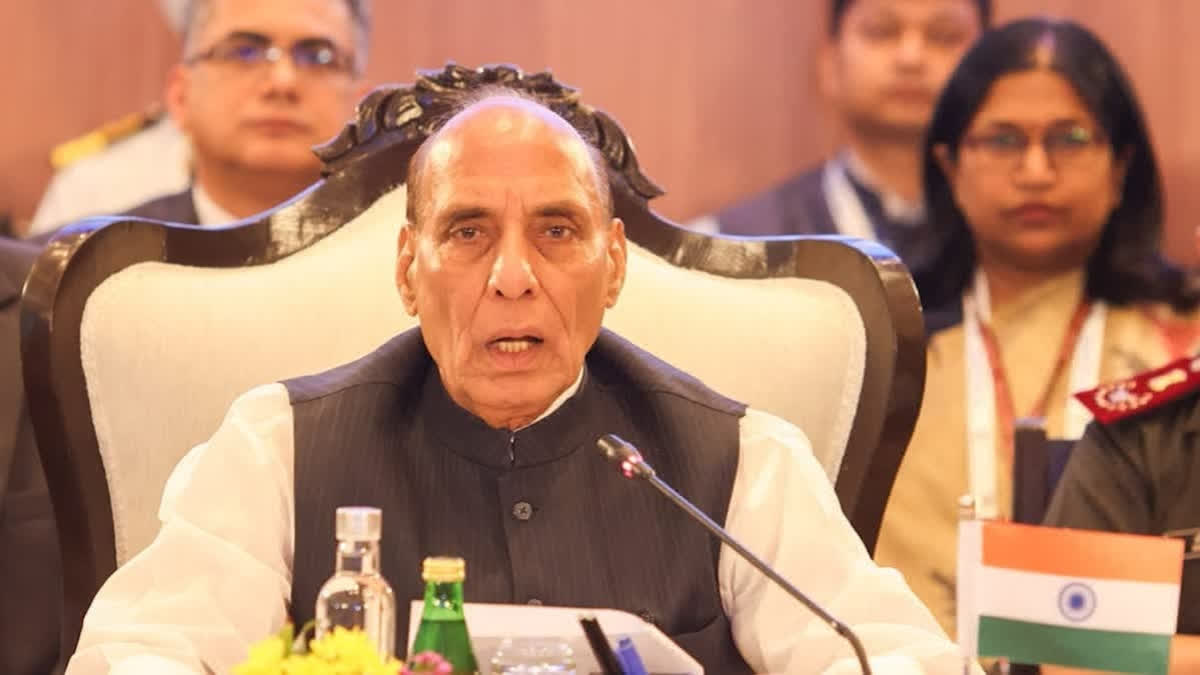New Delhi: The eleventh-hour postponement of Defence Minister Rajnath Singh’s visit to Sri Lanka comes in the backdrop of India’s southern neighbour allowing yet another Chinese ship to enter its waters. Ahead of the visit that was scheduled to take place on September 2-3, the Defence Ministry issued a statement late on Friday evening announcing the postponement.
“Due to unavoidable circumstances, the visit of Raksha Mantri Shri Rajnath Singh to Sri Lanka stands deferred to a later date,” the Ministry statement read. "Shri Rajnath Singh remains committed to strong bilateral cooperation between India and Sri Lanka. He looks forward to visiting the island nation at the earliest possible time frame.”
Also read: Explainer: Why people in Nepal too are protesting against new China ‘standard map’?
During the course of his visit, Rajnath Singh was scheduled to hold talks with Sri Lankan President and Defence Minister Ranil Wickremesinghe and Prime Minister Dinesh Gunawardena. The entire gamut of India’s defence ties with Sri Lanka was supposed to have been reviewed during the meetings.
Rajnath Singh was also supposed to visit Nuwara Elia in Central Sri Lanka and Trincomalee which is located in the eastern part of the country. His visit would have also coincided with the docking of INS Delhi, the Indian Navy’s first indigenously designed and built guided missile destroyer, at Colombo port. Rajnath Singh was supposed to host Wickremesinghe and other Sri Lankan dignitaries on board the ship.
Now, by postponing the visit, New Delhi seems to have sent a subtle message of its displeasure to Colombo for allowing yet another Chinese ship to enter the island nation’s waters.
Despite India’s continued protests to Sri Lanka for allowing Chinese naval ships into its waters, the country’s defence ministry last month granted permission to the Shi Yan 6, claimed to be a research vessel, to enter its waters following a request by the foreign ministry and the National Aquatic Resources Research and Development Agency (NARA).
The vessel, sailing under the flag of China, has a carrying capacity of 1,115 DWT. It is 90.6 metres long and 17 metres wide. According to China’s state broadcaster CGTN, the Shi Yan 6 is a scientific research vessel with a crew of 60 that carries out oceanography, marine ecology, and marine geology tests. But the fact of the matter is that most such Chinese ships have military purposes as well.
The ship will arrive in Sri Lanka on October 26 and dock at Colombo and Hambantota ports. It will stay for 17 days and will carry out research work. Sri Lanka has been trying to assure India that the Chinese vessel will be allowed to conduct research work only in the presence of NARA officials, but New Delhi seems to have not been impressed.
Last month too, a Chinese ship claiming to be a research vessel docked at Colombo port ostensibly for replenishments. The Hao Yang 24 Hao actually turned out to be a Chinese warship. The 129-metre-long ship is manned by a crew of 138 and is commanded by Commander Jin Xin.
In 2022, India had strongly protested when a Chinese survey vessel called the Yuan Wang 5 was allowed to dock at the Hambantota port. Though the ship was described as a research and survey vessel, security analysts said that it was also packed with space and satellite tracking electronics that can monitor rocket and missile launches. The ship was given permission to dock by then-President Gotabaya Rajapaksa a day before he fled the country in the midst of an economic crisis.
Observers say China is trying to show its right to come to the Indian Ocean region. It is trying to show its influence over the countries of the region, which has always been under India’s sphere of influence.
During his visit to India in July this year, President Wickremesinghe had tried to assuage New Delhi’s apprehensions about the presence of Chinese naval ships in his island nation’s waters.
Wickremesinghe said that his country has adopted a new standard operating procedure (SOP) to determine what kind of military and non-military ships and aircraft will be allowed to visit the country. The SOP was adopted following a request by India but its details are not available in the public domain yet. The United States (US) too has been pressurising Sri Lanka not to allow Chinese naval ships in its waters due to security and strategic considerations.
Though Wickremesinghe claims that his country maintains an Asia-centric neutral foreign policy without getting involved in any major power rivalry, Colombo is compelled to maintain equally good relations with both New Delhi and Beijing due to external debt obligations and the economic crisis last year. But the fact of the matter is that Sri Lanka cannot afford to refuse China’s request for permission to allow its ships access to its waters because of Beijing’s huge investments in India’s southern neighbour.
India is part of a Quad that also comprises the US, Japan and Australia which is working for a free and open Indo-Pacific in the face of China’s hegemony in the region. That is why security in the Indian Ocean region has huge strategic implications. Not only for India, what Colombo does in terms of foreign policy and developments in Sri Lanka has wider implications for other major powers’ access to the Indian Ocean.
Now, with the postponement of Rajnath Singh’s visit, Colombo would have understood the mood in New Delhi.
Also read: Philippines rejects China's ‘standard map' claiming entire South China Sea



